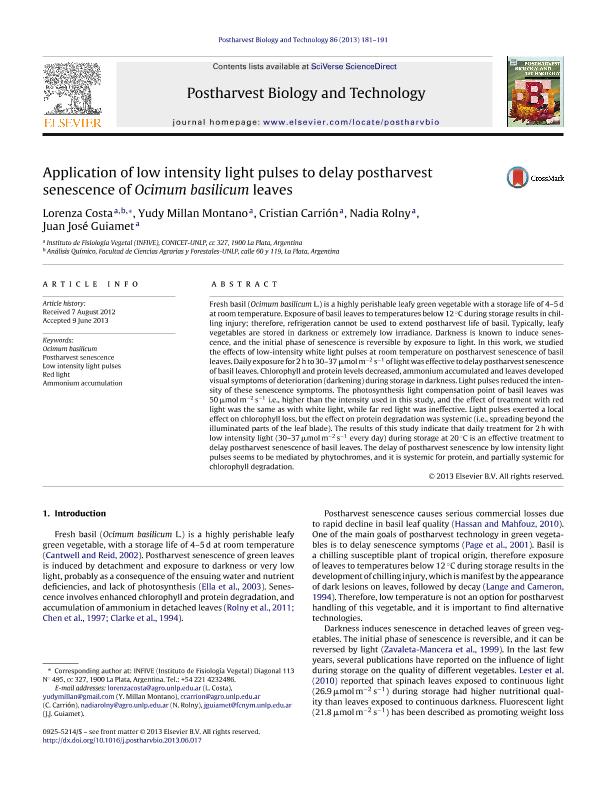Mostrar el registro sencillo del ítem
dc.contributor.author
Costa, M.lorenza

dc.contributor.author
Millan Montano, Yudy
dc.contributor.author
Carrión, Cristian Antonio

dc.contributor.author
Rolny, Nadia Soledad

dc.contributor.author
Guiamet, Juan José

dc.date.available
2017-09-21T20:06:05Z
dc.date.issued
2013-12
dc.identifier.citation
Costa, M.lorenza; Millan Montano, Yudy; Carrión, Cristian Antonio; Rolny, Nadia Soledad; Guiamet, Juan José; Application of low intensity light pulses to delay postharvest senescence of Ocimum basilicum leaves; Elsevier Science; Postharvest Biology and Technology; 86; 12-2013; 181-191
dc.identifier.issn
0925-5214
dc.identifier.uri
http://hdl.handle.net/11336/24838
dc.description.abstract
Fresh basil (Ocimum basilicum L.) is a highly perishable leafy green vegetable with a storage life of 4–5 d at room temperature. Exposure of basil leaves to temperatures below 12 ◦C during storage results in chilling injury; therefore, refrigeration cannot be used to extend postharvest life of basil. Typically, leafy vegetables are stored in darkness or extremely low irradiance. Darkness is known to induce senescence, and the initial phase of senescence is reversible by exposure to light. In this work, we studied the effects of low-intensity white light pulses at room temperature on postharvest senescence of basil leaves. Daily exposure for 2 h to 30–37 mol m−2 s−1 oflight was effective to delay postharvest senescence of basil leaves. Chlorophyll and protein levels decreased, ammonium accumulated and leaves developed visual symptoms of deterioration (darkening) during storage in darkness. Light pulses reduced the intensity of these senescence symptoms. The photosynthesis light compensation point of basil leaves was 50 mol m−2 s−1 i.e., higher than the intensity used in this study, and the effect of treatment with red light was the same as with white light, while far red light was ineffective. Light pulses exerted a local effect on chlorophyll loss, but the effect on protein degradation was systemic (i.e., spreading beyond the illuminated parts of the leaf blade). The results of this study indicate that daily treatment for 2 h with low intensity light (30–37 mol m−2 s−1 every day) during storage at 20 ◦C is an effective treatment to delay postharvest senescence of basil leaves. The delay of postharvest senescence by low intensity light pulses seems to be mediated by phytochromes, and it is systemic for protein, and partially systemic for chlorophyll degradation.
dc.format
application/pdf
dc.language.iso
eng
dc.publisher
Elsevier Science

dc.rights
info:eu-repo/semantics/openAccess
dc.rights.uri
https://creativecommons.org/licenses/by-nc-sa/2.5/ar/
dc.subject
Ocimum Basilicum
dc.subject
Postharvest Senescence
dc.subject
Low Intensity Light Pulses
dc.subject
Ammonium Accumulation
dc.subject
Red Light
dc.title
Application of low intensity light pulses to delay postharvest senescence of Ocimum basilicum leaves
dc.type
info:eu-repo/semantics/article
dc.type
info:ar-repo/semantics/artículo
dc.type
info:eu-repo/semantics/publishedVersion
dc.date.updated
2017-09-14T13:55:18Z
dc.journal.volume
86
dc.journal.pagination
181-191
dc.journal.pais
Estados Unidos

dc.journal.ciudad
New York
dc.description.fil
Fil: Costa, M.lorenza. Consejo Nacional de Investigaciones Científicas y Técnicas. Centro Científico Tecnológico Conicet - La Plata. Instituto de Fisiología Vegetal. Universidad Nacional de La Plata. Facultad de Ciencias Naturales y Museo. Instituto de Fisiología Vegetal; Argentina. Universidad Nacional de La Plata. Facultad de Ciencias Agrarias y Forestales; Argentina
dc.description.fil
Fil: Millan Montano, Yudy. Consejo Nacional de Investigaciones Científicas y Técnicas. Centro Científico Tecnológico Conicet - La Plata. Instituto de Fisiología Vegetal. Universidad Nacional de La Plata. Facultad de Ciencias Naturales y Museo. Instituto de Fisiología Vegetal; Argentina
dc.description.fil
Fil: Carrión, Cristian Antonio. Consejo Nacional de Investigaciones Científicas y Técnicas. Centro Científico Tecnológico Conicet - La Plata. Instituto de Fisiología Vegetal. Universidad Nacional de La Plata. Facultad de Ciencias Naturales y Museo. Instituto de Fisiología Vegetal; Argentina
dc.description.fil
Fil: Rolny, Nadia Soledad. Consejo Nacional de Investigaciones Científicas y Técnicas. Centro Científico Tecnológico Conicet - La Plata. Instituto de Fisiología Vegetal. Universidad Nacional de La Plata. Facultad de Ciencias Naturales y Museo. Instituto de Fisiología Vegetal; Argentina
dc.description.fil
Fil: Guiamet, Juan José. Consejo Nacional de Investigaciones Científicas y Técnicas. Centro Científico Tecnológico Conicet - La Plata. Instituto de Fisiología Vegetal. Universidad Nacional de La Plata. Facultad de Ciencias Naturales y Museo. Instituto de Fisiología Vegetal; Argentina
dc.journal.title
Postharvest Biology and Technology

dc.relation.alternativeid
info:eu-repo/semantics/altIdentifier/doi/http://dx.doi.org/10.1016/j.postharvbio.2013.06.017
dc.relation.alternativeid
info:eu-repo/semantics/altIdentifier/url/http://www.sciencedirect.com/science/article/pii/S0925521413001737
Archivos asociados
